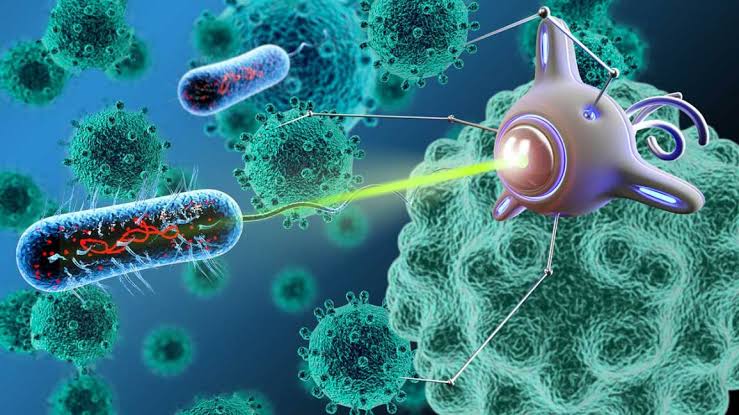For centuries, humans have imagined tiny machines that could travel inside the body, repairing cells, fighting diseases, and even prolonging life itself. From ancient myths of healing elixirs to futuristic visions in science fiction, the concept of miniature helpers working at a microscopic level has fascinated writers, scientists, and dreamers alike.
In 1959, legendary physicist Richard Feynman stood before an audience at Caltech and delivered a visionary lecture titled “There’s Plenty of Room at the Bottom.” In it, he imagined a future where humans could manipulate and build machines at the scale of atoms and molecules. At the time, his ideas seemed fantastical, bordering on magic. How could anyone construct devices smaller than a grain of dust, capable of navigating the inner complexities of living organisms?
Fast forward to today, and what once seemed impossible is inching closer to reality. Scientists are not only designing nanorobots—machines so small they are invisible to the naked eye—but they are also testing them in laboratories and, in some cases, within the human body. This is the story of how humanity is transforming science fiction into medical reality, and how these nanoscopic pioneers might revolutionize medicine forever.
Understanding Nanorobots
Before diving into their rise, it’s essential to understand what nanorobots actually are. A nanorobot is a device built at the nanometer scale—roughly one-billionth of a meter. To put that into perspective, a human hair is about 80,000 to 100,000 nanometers thick. A nanorobot could be smaller than a single red blood cell, yet designed with the intelligence to navigate, sense, and interact with its environment.
These machines are not mechanical robots in the traditional sense with gears and motors. Instead, they are often made from specially engineered molecules, synthetic DNA strands, or tiny pieces of metal and polymers. They can be programmed to perform specific tasks, from delivering drugs to targeted cells to detecting and destroying cancerous tissues.
The field of nanorobotics draws from multiple disciplines—nanotechnology, biotechnology, medicine, and artificial intelligence. The goal is to create microscopic agents capable of performing complex tasks with precision that surpasses conventional treatments.
From Fiction to the First Steps in Reality
Science fiction played an important role in planting the seed for nanorobots. Stories like Isaac Asimov’s Fantastic Voyage envisioned a shrunken crew navigating a miniature submarine inside a patient’s bloodstream to perform delicate surgery. Though shrinking humans remains pure fantasy, the underlying concept—machines operating at the cellular level—captured scientific imagination.
The journey from imagination to tangible progress began with advancements in nanotechnology during the late 20th century. Scientists learned how to manipulate individual atoms, build molecular-scale structures, and develop nanoparticles that could interact with biological systems. This opened the door to medical applications such as drug delivery systems, diagnostic tools, and eventually, nanorobots.
Early nanorobotic designs were simple. Researchers developed nanoparticles that could carry chemotherapy drugs and release them only when reaching tumor sites. These were not true robots but “smart” particles with limited functions. Yet, they marked a crucial first step toward machines capable of autonomous action.
In recent decades, breakthroughs in materials science, molecular engineering, and miniaturized electronics have accelerated progress. Today’s prototypes can navigate fluid environments, respond to biological signals, and perform tasks with astonishing precision.
How Nanorobots Work Inside the Human Body
Imagine a future hospital where instead of invasive surgeries or systemic drug treatments, doctors release millions of nanorobots into a patient’s bloodstream. These tiny machines could travel to specific organs, repair tissues cell by cell, or clear clogged arteries without a single incision.
But how do they work? Scientists design nanorobots with several key features. First, they need propulsion. Since nanorobots cannot rely on traditional motors, researchers use chemical reactions, magnetic fields, or even biological flagella-inspired tails to help them move. Some nanorobots are powered by enzymes that react with glucose or other chemicals naturally present in the body, allowing them to swim through fluids.
Navigation is equally vital. Nanorobots are programmed to recognize specific molecular markers—proteins or chemical signals unique to diseased cells. Using sensors made of nanoscale materials, they can detect these markers and home in on their targets like guided missiles.
Once they reach their destination, nanorobots can perform various tasks. Some are designed to release drugs in precise doses, ensuring that healthy cells remain unharmed while diseased ones are treated. Others can physically break down harmful plaques in arteries or destroy cancer cells directly by generating localized heat or delivering lethal chemicals.
Communication between nanorobots is another emerging capability. Swarms of nanorobots could coordinate their actions, much like colonies of ants, making complex medical procedures possible on a microscopic scale.
Transforming Medicine One Cell at a Time
The potential of nanorobots in medicine is staggering. Diseases that currently require invasive surgeries could one day be treated by sending nanorobots into the body to make repairs invisibly. Cancer treatment, one of the most promising areas, could shift from systemic chemotherapy—which damages healthy tissues—to nanorobots that selectively target and destroy tumors cell by cell.
In regenerative medicine, nanorobots might one day rebuild damaged organs or tissues by assembling molecules at precise locations. For patients with neurological disorders like Parkinson’s or Alzheimer’s, they could deliver therapeutic agents directly to specific neurons, bypassing the blood-brain barrier that often hinders treatment.
Nanorobots could also revolutionize diagnostics. Imagine swallowing a pill containing thousands of nanosensors that scan your entire body for diseases at their earliest stages. These machines could transmit real-time health data to doctors, enabling interventions long before symptoms even appear.
In emergency medicine, nanorobots could stop internal bleeding by quickly sealing wounds from within, buying critical time before traditional medical help arrives. They might also fight infections directly, hunting down pathogens without relying solely on antibiotics, thus combating the growing problem of antibiotic resistance.
Scientific Breakthroughs Bringing Nanorobots Closer to Reality
While many of these scenarios sound futuristic, real scientific progress is rapidly bringing them within reach. Researchers have already demonstrated nanorobots capable of performing tasks inside living organisms, marking historic milestones in medicine.
In one groundbreaking study, scientists created DNA nanobots that could travel through the bloodstream of mice and deliver drugs directly to cancer cells, shrinking tumors without harming surrounding tissues. These DNA-based machines folded themselves into complex shapes that could open and close like origami boxes, releasing therapeutic molecules on command.
Another breakthrough involved magnetically controlled nanorobots that could swim through fluids and clear bacterial infections. By manipulating them externally with magnetic fields, doctors could steer these tiny machines precisely to infection sites.
Even more advanced designs use biological components, merging living cells with synthetic materials to create hybrid nanorobots. These bio-hybrids can harness the natural mobility and sensing abilities of bacteria while carrying synthetic payloads for medical tasks.
Advances in artificial intelligence are also playing a role. Machine learning algorithms help design nanorobots that can adapt to complex biological environments, improving their efficiency and safety. As computational power increases, the ability to simulate and optimize nanorobot behavior at molecular levels becomes ever more sophisticated.
Challenges on the Path to Medical Reality
Despite these remarkable advancements, many hurdles remain before nanorobots become routine in hospitals. The human body is an incredibly complex and hostile environment for machines. Immune systems may attack nanorobots, rendering them ineffective. Ensuring they do not accumulate in organs or cause long-term toxicity is critical.
Manufacturing nanorobots at scale is another challenge. Creating billions of perfectly functional, uniform machines small enough to navigate the bloodstream requires unprecedented precision and cost-effective processes.
Safety and ethics also weigh heavily on researchers’ minds. If nanorobots can travel freely through the human body, how do we ensure they only perform their intended functions and do not malfunction or replicate uncontrollably? Regulatory frameworks will need to evolve alongside the technology to address these concerns.
Public perception presents yet another barrier. The idea of tiny robots coursing through our veins can evoke fear as much as hope. Transparent communication about risks and benefits will be essential to gaining widespread acceptance.
The Ethical Horizon of Nanomedicine
With every revolutionary technology comes profound ethical questions, and nanorobotics is no exception. Who should have access to such advanced treatments? Could they widen the gap between wealthy and poor nations in healthcare? What safeguards are necessary to prevent misuse, such as creating weaponized nanorobots or unauthorized surveillance inside the human body?
There is also the question of enhancement versus healing. If nanorobots can repair cells, could they also be used to enhance them—making humans stronger, smarter, or more resilient than nature intended? Such possibilities blur the line between medicine and transhumanism, raising philosophical debates about what it means to be human.
Bioethicists and policymakers are beginning to grapple with these issues, emphasizing that progress must be guided by strong ethical principles. The goal is not only to push the boundaries of science but to do so responsibly, ensuring that nanorobots become a force for healing, not harm.
Looking Ahead: The Future of Nanorobotics
The trajectory of nanorobotics is accelerating. As research continues, experts predict that within a few decades, nanorobots could become as common as today’s surgical tools or MRI scans. Early applications in targeted drug delivery and diagnostics will likely pave the way for more complex therapies.
Eventually, swarms of autonomous nanorobots could patrol our bodies continuously, repairing cellular damage, neutralizing pathogens, and even preventing diseases before they take hold. Such technology could dramatically extend human lifespan and improve quality of life, making chronic illnesses and many forms of cancer relics of the past.
Outside of medicine, nanorobots might be used to clean environmental pollutants, build materials atom by atom, or explore microscopic ecosystems in nature. The ripple effects of mastering nanoscopic machines could transform multiple industries, fundamentally changing the relationship between humans and technology.
Science Fiction Becomes Science Reality
The rise of nanorobots is a testament to human ingenuity. What began as imaginative speculation is steadily becoming real through decades of relentless research and innovation. As scientists inch closer to deploying these microscopic machines in hospitals, we are witnessing one of the most profound transformations in the history of medicine.
Nanorobots symbolize more than technological progress; they embody a deeper aspiration—the desire to conquer disease at its roots, to heal not just organs but individual cells, and to unlock the full potential of the human body.
There will be obstacles, uncertainties, and ethical dilemmas along the way. Yet, as history has shown, humanity thrives on challenges that once seemed insurmountable. The dream of nanorobots navigating our veins, silently repairing and protecting us, is no longer confined to the pages of science fiction. It is steadily becoming part of our shared future, one nanometer at a time.






